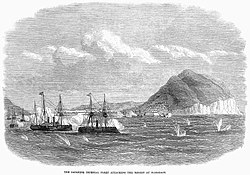
Back تاريخ اليابان البحري Arabic Geschichte der japanischen Seefahrt German Histoire navale du Japon French Sejarah Angkatan Laut Jepang ID 日本の海軍史 Japanese Lịch sử hải quân Nhật Bản Vietnamese 日本海军历史 Chinese
| Part of a series on the |
| History of Japan |
|---|
 |
The naval history of Japan began with early interactions with states on the Asian continent in the 3rd century BCE during the Yayoi period. It reached a pre-modern peak of activity during the 16th century, a time of cultural exchange with European powers and extensive trade with the Asian continent. After over two centuries of self-imposed seclusion under the Tokugawa shogunate, Japan's naval technologies became outdated compared to Western navies. The country was forced to abandon its maritime restrictions by American intervention with the Perry Expedition in 1854. This and other events led to the Meiji Restoration, a period of frantic modernization and industrialization accompanied by the re-ascendance of the Emperor's rule and colonialism with the Empire of Japan. Japan became the first industrialized Asian country in 1868, by 1920 the Imperial Japanese Navy was the third largest navy in the world and arguably the most modern at the brink of World War II.
The Imperial Japanese Navy had a history of successes, sometimes against much more powerful foes as in the 1894–1895 Sino-Japanese War, the 1904–1905 Russo-Japanese War, and early naval battles during World War II. In 1945, towards the end of the conflict, the navy was almost completely destroyed by the United States Navy. Japan's current navy is a branch of the Japan Self-Defense Forces (JSDF) called the Japan Maritime Self-Defense Force (JMSDF). In 2015, the JMSDF was ranked by Credit Suisse as the fourth most powerful military in the world.[1] However, it is still denied any offensive role by the nation's post-war Constitution and public opinion.